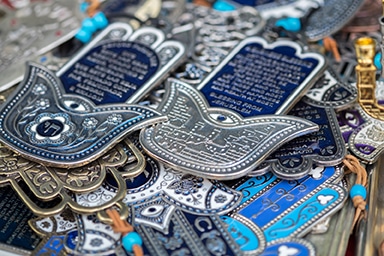
The Role of Admissions in Sustaining and Changing Culture
March 5, 2019
Promoting the Teacher-Student Relationships: Practical Suggestions
March 5, 2019Gefilte fish, large noses, Seinfeld, kugel, light skin, doctors, lawyers, accountants and last names like Friedman, Goldberg, Katz, Rosenberg and Schwartz. When a Sephardic student sees these American-Jewish stereotypes, he does not see his family, friends or community reflected.
The Sephardic community in North America is growing quickly. It’s not just the burgeoning enclaves of Syrians in Brooklyn and Deal, Bukharin in Queens and Phoenix, Persians in Great Neck and LA, and Moroccans in Montreal. Though each Sephardic community has its own norms and mores, on the whole Sephardim marry younger, have more children and are more traditional than Ashkenazim. They are the fasting growing Jewish community in (of all places) Manhattan.
As Sephardim venture forth from these enclaves and become significant minorities (and in some cases, majorities) in day schools from coast to coast, we must ask, “Are we servicing our Sephardic students and families as best we can?” Are we tailoring our curriculum, programming, and messaging to speak to our Sephardic families? Does our school’s culture reflect and deepen our students’ Sephardic Jewish identity?
Not long ago there was a prevalent, unstated opinion amongst rebbeim that we have to supplant the strong Sephardic ethnic identity with a theoretically-ethnically “neutral” religious identity.
I would argue that the opposite is true- the stronger a student’s Sephardic identity, the stronger their commitment to Judaism. We have to remember that Sephardic Jewry isn’t fractured into Chassidish, Conservative, Orthodoxy, Reform, etc., so the Sephardim who send their children to an Orthodox day school adhere to a wide range of observance and beliefs. On this background, the Sephardic fidelity to tefilla b’tzibbur and taharat hamishpacha are remarkable. As Ashkenazic educators, we need to understand our Sephardic families’ food, dress, slang, humor, piskei Halacha, minhagim, and cultural norms and mores, so we can plug into and strengthen our students’ Jewish identity.
My experience of being a teacher in an Ashkenazic-minority school (which was originally thoroughly Ashkenazic) truly informed and inspired the culture that we created in the new school I started in a different region of the country (where our student body was consistently 20% Sephardic). Having seen the world through the eyes of the Ashkenazic minority, I was determined to make our Sephardic students feel as “at home” as possible.
You may find it helpful to think of our Sephardic students as “Students of color”. Many of their parents were not born in the US, and English is not the mother tongue of many of their families. Like Ashkenazim, the first generation of Sephardim in North America earn(ed) their living through business (as opposed to professions). They are assimilating into western culture slower than other Jews (which is arguably a good thing). Just like political parties, corporations and public schools go to great lengths to be welcoming and accessible to people of color, Ashkenazic-run schools need to be thoughtful and proactive in creating well-designed Sephardic programs and curricula. I’d like to suggest a few.
- Sephardic Minyan
I’m always surprised when I hear that a school has a Sephardic minyan one or two days a week. Would you force Ashkenzic students to daven (or pray) Sephardic three to four days a week? The desire to have the entire school pray together is admirable, but at what cost?
I think it’s important that administrators daven weekly with the Sephardic minyan. It sends a powerful message to the students, and it sensitizes the administrators to the needs of this community.
One of the challenges of running simultaneous Ashkenazic and Sephardic Shachari(s)(t) minyanim is the fact that Sephardic minyanim take much longer. Not only does the chazzan say every word out loud, but Uva L’tzion seems to be the midpoint. Korbanot, which are admirably nearer and dearer to Sephardim, have to be said before minyan begins. If your school serves breakfast, the Sephardim may unfortunately have to miss most or all of it. On Rosh Chodesh, your Sephardic minyan should consider doing a “heiche kedusha” for mussaf (which many Sephardim do for mussaf regularly).
For mincha, I suggest that the minhag follow the chazzan. It’s not difficult to print mincha cards that have the amida, kedusha, kaddish, etc. of both nuschaot, or at least just the kedusha of the other minhag. A middle or high school student should be comfortable walking into any shul. On fast days, Sephardim need a separate mincha minyan. Some boys put on tefillin and most Sephardic communities do not read haftarot.
The halacha section at the back of the Koren Sephardic siddur is particularly helpful in identifying the differences in davening. Since different Sephardic communities have different minhagim (and different siddurim), there must be a way to decide which customs your minyan will follow. - Sephardic Halacha
Rabbi Chaim Jachter writes a weekly article in the New Jersey Link about the differences between Sephardic and Ashkenazic practices. Rabbi Jachter is not only an Ashkenazi who serves as the rabbi of a Sephardic shul which has members from the full range of Sephardic communities, he is a rebbe in a yeshiva high school. About to be published as a book (tentatively entitled “Sephardic Savvy: Demystifying 101 Facets of Sephardic Halacha”), these articles are invaluable to an Ashkenazic teacher of Sephardic students.
When possible, I suggest offering a Sephardic Halacha course in an elective slot. Halacha is often a stepchild in a yeshiva high school curriculum, crowded out by its big brother Gemara and middle siblings Chumash and Navi. Halacha study is much more central to Sephardim, and a few periods a week of its study goes a long way in making Sephardic students feel at home. - Sephardic Programs for All
At our school we created an annual program which celebrated Sephardic culture which we called SephardiGras. It consisted of the entire school praying a Sephardic Shacharit, serving a Sephardic breakfast with Sephardic music playing in the background, and a fun/educational program about Sephardic culture.
Tefillah was a central educational element of Sephardi Gras. The day before, we invited a Sephardic rabbi to speak to the Ashkenazic students (often at the end of a davening) to explain the differences between Sephardic and Ashkenzic davening. With both types of prayer books open in front of them, the rabbi pointed out the differences between what is said privately and out loud and when one stands and when one sits. Warning the Kohanim that they’ll be duchening is a must!
I discussed the question of how the Ashkenazic students should daven in this situation with Rav Herschel Schachter. Because the purpose was to familiarize the students with Sephardic davening so they would be comfortable in Sephardic shuls, Rav Schachter said that they should follow the Sephardic davening and minhagim. If it would not confuse a student too much, Rav Schachter said it was preferable that they daven their silent shemoneh esrai in their regular nusach.
This day started as a themed Rosh Chodesh, but we quickly realized that Sephardic weekday davening is long, and Sephardic Rosh Chodesh davening is REALLY long. We often ran it as the quasi Rosh Chodesh program during a month when Rosh Chodesh fell on a weekend.
After davening, the Sephardic students dressed up in colorful Sephardic garb (borrowed from parents and community members) and the entire school was treated to a breakfast of shakshuka, malawach, jachanun, etc. After breakfast, there was a student-run program about Sephardic halacha and/or culture. Some years the program was a game show, others a split-screen play of Sephardic and Ashkenazic rituals, and sometimes it was a history lesson about the different Eidot Hamizrach.
We wanted Sephardic to be viewed as fun and cool (hence the choice of the name Sephardigras), and I think this program went a long way to accomplish that.
Jews Indigenous to the Middle East and North Africa (JIMENA) has designed educational and experiential programs for day schools (http://www.jimena.org/jewish-day-school-program/) including Around the Middle Eastern Jewish World, Celebrating Sephardic Clothing, Forgotten Refugees, Henna Party, Open Your Hand – HAMSA, Middle Eastern Jewish Cuisine, Hafla! The Roots of Mizrahi Music, Oral Histories, Photomapping, Sephardic Storyteller, Our Names, Our Identity, and My Heart is the in East: Mizrahi Museum. - Student Council
By convention, the president of Lebanon is a Maronite Christian and the prime minister is Muslim. We decided to have both a male and a female school president, and male and female presidents of each grade. I met with the school presidents once a week, and the presidents of each grade once a month. For many years, we happened to have both Sephardic and Ashkenazi school presidents. Just like the genders often had different concerns, so, too, the Ashkenazim and Sephardim had different worldviews. I highly recommend creating a venue for Sephardic student concerns to be aired and addressed. - Sephardic-Only Programs
There are things that just the Sephardim celebrated. Birkat HaIlanot isn’t that popular in the US amongst Ashkenazim but was important for our Sephardic minyan. The parent who led our minyan invited the Sephardic students to his home on a school day in Nissan for breakfast and to make the bracha on the early-budding fruit tree in his backyard. Though it meant missing a period or two of class, I felt it was a reward for these students’ missed breakfasts throughout the school year due to their minyan’s length. A similar program could be run on the hilula (yarzheit) of a great Sephardic rabbi or community leader.
In summary, I suggest that it’s worthwhile to consider similar programming for other minorities in our schools, such as students whose families have been inspired by Lubavitch. They have holidays such as Yud Tes Kislev and Chof Beis Shvat, and minhagim such as no selichos between Rosh Hashanah and Yom Kippur. With shluchim in every corner of the globe, all our students will encounter Chabad. These days are great opportunities to bring in Lubavitch men and women to explain their worldview to all students. Having an optional Tanya shiur during lunch or as an elective is certainly of consideration.
May we succeed at making all students feel at home in our schools, and may our students learn from, and be enriched by, our differences.
Rabbi Perry Tirschwell taught at the Hillel Yeshiva High School in Deal, NJ, and was the Founding Head of School of the Katz (formerly Weinbaum) Yeshiva High School in Boca Raton. He is the Founding Director of the Torah Educators Network, whose mission is to enable yeshivas to share innovative ideas and do things that they could not do on their own. He is a graduate of Yeshivat Har Etzion, YU, RIETS and the Graduate School of Education of the College of New Rochelle.

